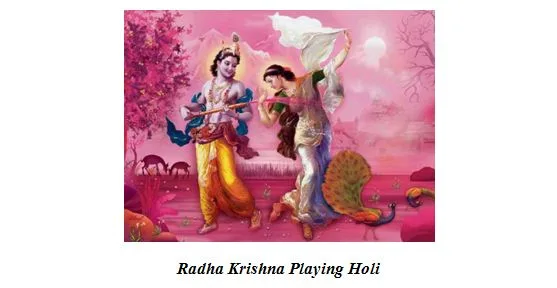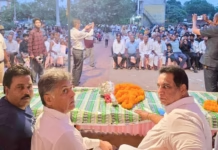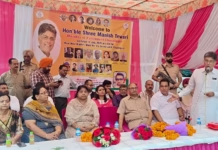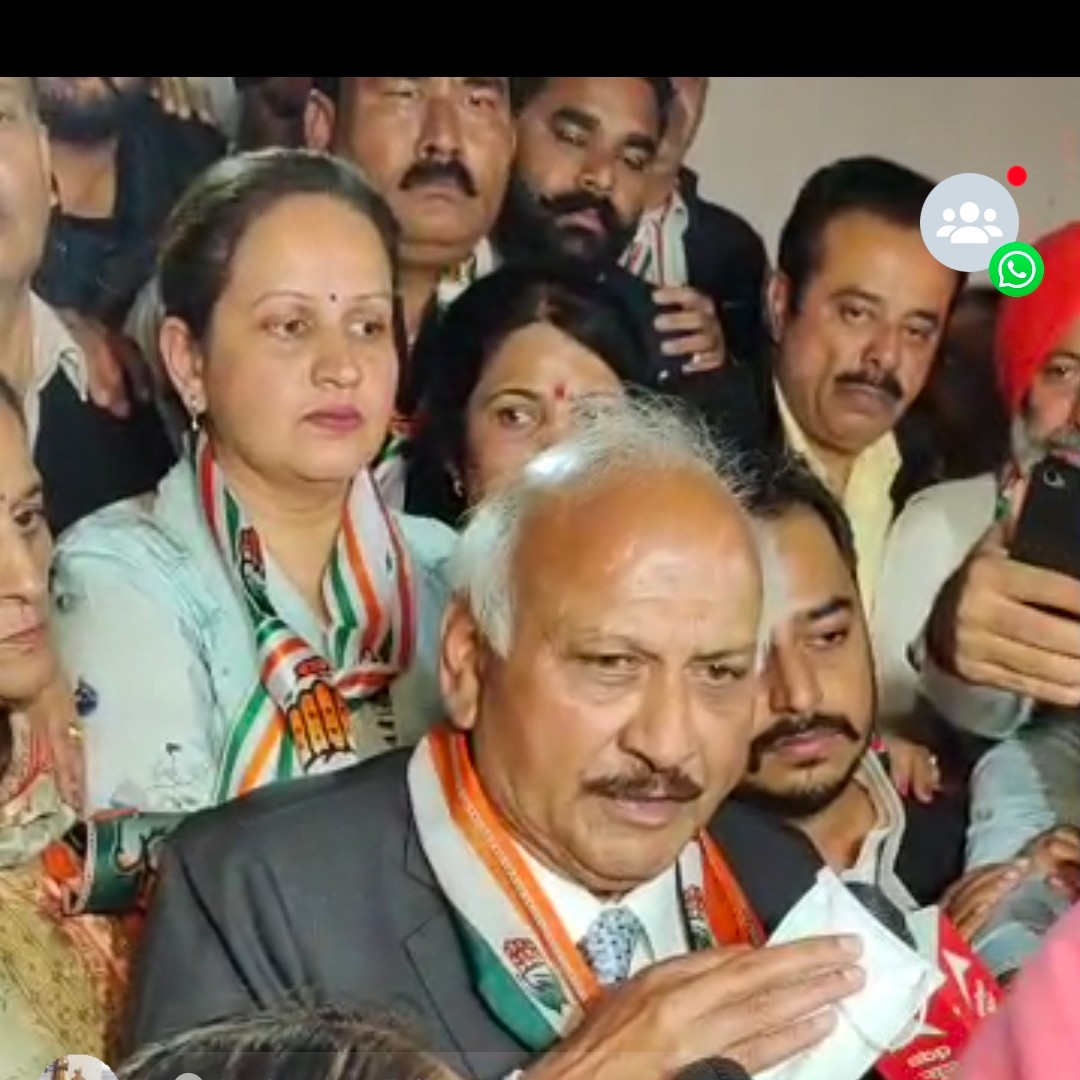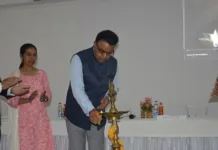Holi Festival: a festival of joy, colours-Puri
Jaswant Singh Puri/ March 25,2024
Holi is a significant festival celebrated as the festival of colours, love and spring with full fun and frolic. It is a unique celebration of the divine love of the deities Radha and Krishna. Moreover, this festival emphasizes the triumph of good over evil. It commemorates the victory of Vishnu as Narsimha over Hiranyakashap. Holi is mainly solemnized in the Indian subcontinent but now it is celebrated with fervour in other regions of Asia and Western countries among the Indian diaspora.
The Holi festival celebrates the dawn of spring in India and the fragrant buoyancy of love. It is an invocation for a rich harvest season. It falls on the full moon day in the month of Phalguna. The festival is also known as ‘Dol Purnima’, ‘Dhulandi’, ‘Phagwah’ etc. In the seventeenth century, it was identified as a festival of celebration of agriculture, good spring harvesting – season and the fertile land. It is also a time to bid adieu to winter season. It is also a golden occasion to renew old conflicting relationships and ties. The festival also serves symbolically by the legend of Holika. Holika Dahan is ceremonised by having bonfires. The Holi is also a day of serving delicacies like ‘Gujia’ etc. to the guests and other desserts and drinks. In some regions of India, ‘Kama Dahanam’ is celebrated like ‘Holika Dahan’ where the festival of colours in these regions is known as ‘Rangapanchami’ which takes place on the fifth day after ‘Poornima’.
The Holi festival has its cultural rituals since the Gupta Period or even before this period. The festival of colours does find a mention in works like ‘Jaimini’s Purva’, ‘Mimamsa Sutras’, ‘Narada Purana’ and ‘Bhavishya Purana’. The festival also finds a mention in the seventh century scripture ‘Ratnavali’ by King Harsha. It finds its place during the fourth century reign of Chandragupta by the poet Kalidasa.
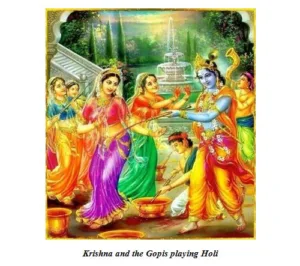
The festival is celebrated in the Braj region of India where the deities Radha and Krishna grew up. The day is celebrated as a festival of love. ‘Garga Samhita’ was the work of literature by Sage Garga who illustrates the romantic portrayal of Radha and Krishna enjoying Holi. The playful colouring of Radha and Krishna’s faces has been commemorated as Holi. The festival has spread it wings in some Caribbean countries of Indian origin such as Guyana, Suriname, Trinidad.
History mentions it significance to the legend of Prahlada, a devotee of Vishnu and the vainglorious king Hiranayakashyap who was killed by Vishnu in the form of Narsimha avatar. The Holika bonfire and Holi signify the celebration of the symbolic victory of good over evil, of Prahalad over Hiranayakashyap and the fire that burned Holika. In Shaivism and Shaktism, the legendary importance and dominance of Holi is related in Yoga and meditation.
The Holi festival showcases a cultural significance to end and get rid oneself of past errors and to put a stop to conflicts by forgetting the past rivalry and revel in the present. Holi is particularly of immense grandeur in places associated with Radha-Krishna like Mathura, Varindavan, Nandgaon, Barsana and Gokula which become attractive spots for the tourists during Holi season. In Mughal India also, Holi was celebrated by all castes in the majestic company of the emperor. Impressive celebrations were organized at the Lal Qila where the festival was known as Eid-e-gulaabi. But Aurangzeb banned the celebration of Holi. Sikhs have been celebrating the festival referring to it as ‘Hola’. The tenth Nanak Sri Guru Gobind Singh modified Holi with a three day ‘Hola Mohalla’, a festival of martial arts. It is celebrated in Anandpur Sahib where Sikh soldiers are trained and made adept in mock battles, horse-riding, archery and military skills. Even Maharaja Ranjit Singh played Holi with others in the decorative tents. The Colonial British Officials also joined these celebrations.
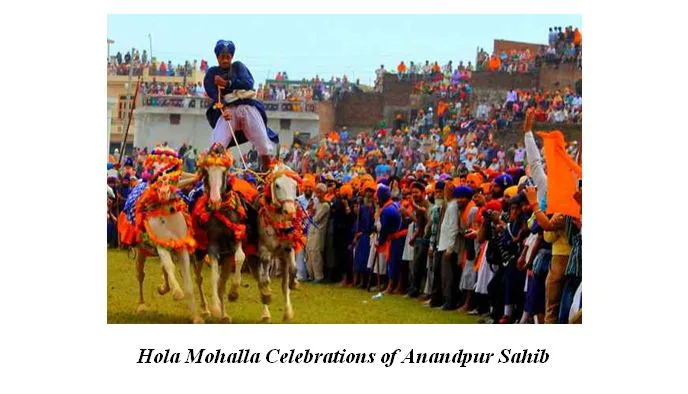
Many places organize Kavi Sammelans in the evening to enjoy the delights of Holi. Holi Milan is observed in Bihar where family members and well-wishers visit families of known ones to play with colours. In Gujrat, Holi is a two-day festival of festivity. Dwarka is a coastal city of Gujrat where Holi is enjoyed at the Dwarkadhish temple with fun and frolic of musical flavour. In Sirsi of Karnatka, Holi is celebrated with an exquisite display of folk dance called ‘Bedara Vesha’. Holi Purnima is also enjoyed to its full dose of festivity in Maharashtra that lasts five to seven days and called Shimga. The eight days preceding Holi in Punjab are known as ‘Luhatak’. Holi days are thus pleasant when trees and plants start blossoming and bear fruit.
Holi is known as ‘Phaguwa’ or ‘Fagua’ in Bhojpuri language. It is also a part of the Konkani Spring Festival. It is a matter of joy for Manipuris who celebrate Holi for six days. In Tamil Nadu, it is associated with‘Panguni Uthiram’ festival that portrays the wedding of various Hindu deities like Parvati and Shiva, Murugan and Devasena, Rama and Sita and Andal and Ranganatha on this day. Barsana, a town near Mathura in the Braj region, Lathmar Holi is celebrated in the compound of Radha–Rani Temple. A traditional celebration includes ‘Matki Phod’ which is a sport ritual and goes on in Hindu communities. Holi is known as ‘Basanta Utsav’ in Shantiniketan by worshipping the icons of Radha and Krishna. It is celebrated as a National Festival in Nepal. It is also celebrated in many US states by Asian Americans.
Now a word of caution for the Holi celebration and the use of colours. Earlier, the colours were made of neem, kumkum, haldi, bilva and other herbs as suggested by doctors. The use of sandalwood, dried hibiscus flowers were in practice. But it has been found in recent years that the colours have become toxic due to use of chemicals since they are very cheap but detrimental for the skin, eyes and cause allergic reactions. Dr. Ajit Singh Puri’s Health Guide ‘Speaking of How to Prevent Common Diseases’ is a world acclaimed book that bears a Foreword by Lord Walton of Detchant, Former President, British Medical Association, Royal Society of Medicine and General Medical Council contains an important chapter on ‘Allergy and Bronchial Asthama’ where he clearly and candidly mentions: “Allergy and bronchial asthama are closely related”. An allergy is a very complex problem and the patient may suffer from more than one or multiple types of allergies. To avoid allergies, one should keep away in using toxic colours on Holi and other festivals. The use of heavy metal-based pigments during Holi is reported to cause pollution and allergic reactions.
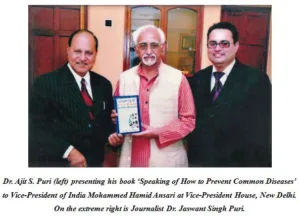
Alka Puri during her tenure as Secretary, Ladies Club, Punjabi University, Patiala organised Holi festivities in a true spirit of its importance by managing various snacks and mouth-watering desserts and delicacies. The assemblage at the festival always won her immense appreciation and good will.
A number of Holi inspired social events have surfaced in Europe and the United States. Schools across Australia have also adopted fund raising activities. Let us be careful in the use of colours and powders to avoid allergies and bronchial diseases.

Note: The views expressed are personal. This article is dedicated to Smt. Alka Puri wife of Dr. Ajit Singh Puri and mother of Jaswant Singh Puri.

